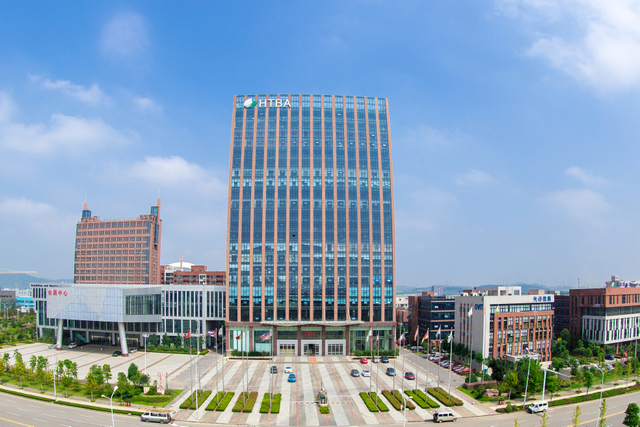HTBA
Hi-tech Agri Group: Reaching for the summit of Bio-Agriculture in China

With strong backing from the Hubei and Wuhan governments, the HTBA is striving to establish the top bio-agricultural park in China by nurturing an innovation ecosystem with advanced facilities to support cutting-edge research focused on developing ground-breaking solutions for agriculture. These efforts are already bearing fruit, with important technological breakthroughs having been achieved by companies within the park.
HTBA broke ground on Nov 19, 2009, and today covers over 2000 acres, with a total building area of 1.2 million square meters, and a projected investment exceeding 10 billion RMB. HTBA has three primary areas of technological focus, bio-breeding, animal vaccines, and biological feed additives. HTBA is currently laying the groundwork for a powerful industrial cluster that within five years will be made up of over a 100 Chinese bio-agricultural enterprises. At that time HTBA is expected to contribute a third of the 100 billion RMB in projected bio-industry revenue across the entire East Lake Hi-Tech zone.
There are three policy categories which underpin the HTBA. The first category is a set of preferential policies promoted by the East Lake Hi-Tech Zone to support a National Innovation Model Area. The second category is a set of financial incentives to promote the commercial activities of ‘talented’ individuals with valuable knowledge and skills. And the third category relates to a range of national, provincial, and municipal policies to encourage bio-agricultural initiatives. Further support comes from government investment, financial support for proprietary technology, international venture capital, financing and company IPO assistance.
The construction of major infrastructure, such as roads, pipelines, sewage treatment, steam, and gas supply, is almost complete. A stream that runs through the park has been specially landscaped to form a 1.5 kilometre ecological corridor supporting bio-diversity. Key facilities have been constructed and are available to companies moving into the park, including buildings for corporate headquarters, a hotel, a meeting and exhibition centre, an R&D centre, staff dormitories, expert apartments, a bank, a post office, stores, restaurants, and a gym.
The HTBA offers a compelling range of favourable conditions and opportunities, including great services and amenities, preferential policies, a strategic location in Central China, and a tremendous pool of talent streaming out of the largest university population in the world, right in our own backyard. These advantages have attracted business leaders and investors from around the world to join this growing innovation hub. More than 60 leading companies have settled in the park and over 200 projects worth over 12 billion RMB have been signed, of which 21 are already up and running.
A number of Fortune 500 companies have entered the park like Germany’s Bayer Group, Dupont Pioneer from the US, who is setting up a canola breeding R&D center, and Syngenta from Switzerland, who is partnering with the China National Bio-pesticide Engineering Center on natural pest control solutions. In addition, ViaGen Biotech, a US genetics company which owns the revolutionary technology used to breed the first cloned sheep, Dolly, has built a world-class animal molecular cloning and breeding center here. Finally, Shirat (Q5?), a leading incubator management company from Israel, has helped to establish the first international bio-agricultural business accelerator in China, attracting a range of dynamic small and medium enterprises to the HTBA to help drive the next wave of entrepreneurial growth and innovation.
HTBA is also attracting major domestic players. For example in the seed sector,
Professor Zhang Qifa from Huazhong Agricultural University, is cooperating with the China National Seed Group to invest over 5 billion RMB to build the largest bio-agricultural R&D center in China. Other important seed companies in the park include:
· Fengle Seed, the first listed seed company in China;
· Huiming Seed, the biggest transgenic cotton seed company in the country;
· Hubei Provincial Seed, which ranks first in seed exports from China;
· and Wuhan Guoying Seed, lead by one of the foremost breeding researchers in the country, Professor Zhu Yingguo of Wuhan University.
Together these represent an important industrial cluster, turning the HTBA into the ‘Seed Capital of China’.
Other notable domestic companies in the park include:
· the China National Agricultural Development Group, one of the largest integrated agricultural enterprises in China;
· the China Veterinary Institute of the Military Academy of Medical Sciences;
· Zhongbo Bio-products, a leading innovator in the field of animal vaccines;
· Keqian Animal Biological Products, led by a leading figure in the field of animal disease control, Prof Chan Huanchun;
· Wuhan Sunhy Group, the largest enzyme producer in Asia;
· Beijing Vica Group, a leader in feed additives;
· Wuhan Heyuan Green Bio-engineering, specialising in agricultural micro-organisms;
· Hubei Forbon, a pioneer in the field of slow release fertilisers;
· Hubei Sheridan, China’s biggest egg processing company;
· Wuhan Yisheng bio-tech, which produces fine organic teas for export;
· Wuhan Xin Taiyang, the biggest online B2B player for agricultural products in central China;
All of these enterprises and institutes have begun to grow roots within the HTBA. Under the guidance of the East Lake National Innovation Model Area and the Wuhan National Bio-Industrial Base, the HTBA is evolving into a diverse and vibrant bio-agricultural ecosystem, which is already beginning to blossom with innovation.
